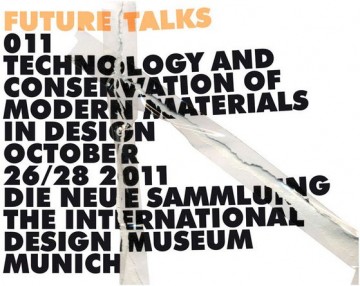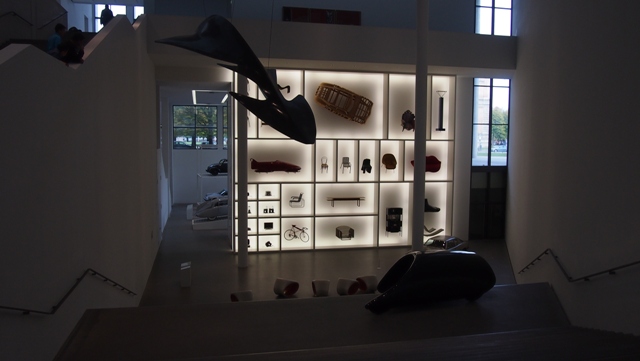Over the past two months, I’ve had the good fortune of attending two international conferences that dealt with the conservation of contemporary art: the International Council of Museums – Committee for Conservation (ICOM-CC) held its 16th Triennial Conference in Lisbon, Portugal, and Future Talks 011 was held at Die Neue Sammlung in Munich, Germany.

The ICOM-CC Triennial is designed to serve a broad audience of conservators; with 21 different “working groups,” contemporary art is just one part of the focus of the conference. While generally I think it’s a good idea to look at conference themes as just rough guides for what the conference talks are supposed to be about, I’m still scratching my head at the theme for this Triennial: “Cultural Heritage vs Cultural Identity: The Role of Conservation.” How is it possible for these two things to be in competition?
You can download the complete list of ICOM-CC papers here, and read journalist Sarah Evert’s good reporting about the conference, but what I was most interested in was the Modern Materials and Contemporary Art Working Group and the Documentation Working Group. In total there were about 15 talks in these Working Groups that dealt with conservation projects of contemporary art. Not surprisingly, many of the talks dealt with caring for plastics, for example:
- A preliminary study into the swelling behavior of artists’ acrylic emulsion paint films. E. Kampasakali, B. Ormsby, A. Phenix, M. Schilling, T. Learner
- Back to transparency, back to life: research into the restoration of broken transparent unsaturated polyester and poly(methyl methacrylate) works of art. A. Laganá, T.B. van Oosten
- Wiping away the dirt – a safe option for plastics? Y. Shashoua, K. Segel, T. van Oosten, A. Laganá, B. Keneghan, G. Barabant, C. Bollard, S. Kuperholc
In the talk on safe options for wiping plastics, a slide was shown that illustrated the “Mechanical Cleaning Vectors” for more than 20 different methods for wiping dust and grime off of plastics. When you’re considering a slide like that, you know you’re at a conservation conference.
There were also talks by about artworks by Lourdes Castro, Martin Kippenberger, Ger van Elk, members of the “Arte Povera” group, and some of the “Finish Fetish” artists currently being celebrated in the Getty’s Pacific Standard Time project.
Of particular note was Eleonara Nagy’s talk about the conservation of Claus Oldenburg’s Ice Bag, from 1971 (the avid Art 21 Blog reader will remember my conversation with Nagy about the conservation of Judd artworks from this summer). The Oldenburg conservation project was a multi-layered, collaborative effort. You can listen to Oldenburg talk about the project from a video from the Whitney’s YouTube account:
In the Documentation Working Group, a few web-based projects were highlighted. While they don’t have to do with contemporary art, the Rembrandt Database project and the Master of the Fogg Pietà project, both funded by the Andrew W. Mellon Foundation, are interesting examples of using web-based technology to get conservators to collaborate internationally to create a critical amount of information around an artist and artwork (unfortunately, as of yet neither project has made their information available to the rest of us, but this will come soon).
Folks from the Getty and DIA project to document Robert Smithson’s famous Spiral Jetty discussed some of the how-to details of attaching a camera to a balloon and then floating it over the Jetty (this project was also discussed on the Art 21 Blog in 2009). Finally, a new project aimed at documenting Dan Flavin’s fluorescent lights (many of the lights used in Flavin’s artworks are becoming very difficult to find) was presented by Guggenheim conservator Francesca Esmay.

Dan Flavin installation at the Menil Collection. Image courtesy Wikipedia.
If the ICOM-CC Triennial treated modern and contemporary art as just one part of a spectrum of concerns facing art conservators, Future Talks 011 at Die Neue Sammlung focused directly on the “Technology and Conservation of Modern Materials in Design.” This is the second year of this conference–the best on the conservation of design arts in the world–which is brilliantly organized by Die Neue Sammlung conservator Tim Bechthold (I talked to him about Future Talks 009 on the Art 21 Blog in 2009).

There were just under 30 talks presented over three days, covering a wide variety of topics (find the full list of talks here). As with ICOM-CC, there were talks that focused on designers and artists and those that dealt with the materials used in creating design objects. The number of talks given by European graduate students makes it clear that EU countries have spent a lot more time researching methods for conserving contemporary art than in the past; this is evidenced by the increasing number of European graduate programs dedicated to the conservation of contemporary art (with the Spanish the most recent to start a Master’s program at the Museo Reina Sofia).
What became clear to me after attending these conferences is that today, cultural institutions and collectors are faced with occasionally dramatic examples of materials that were not designed to last – from Polaroids to plastics to food. Increasingly, artworks made of new materials are filling up galleries and storage areas, yet they remain in a continual state of degradation. I don’t want to be an alarmist, because it’s clear that not all contemporary materials are rapidly degrading, but many have been dramatically changing since the late 1940s.
In response, institutions, conservators and conservation scientists have been spending an incredible amount of time, money, and resources trying to understand how new materials degrade and are working to discover ways to slow the process or repair the damage when possible. However, in the end, institutions can be left with difficult choices, such as not exhibiting an important artwork, or considering the best way to re-make it.
After these two conferences I left wanting to hear a talk that looked head on at the ephemerality of contemporary art and design materials. A talk that demonstrates that knowing how long materials will last is also the responsibility of artists and designers. Some have suggested that artists should be educated about using “archival materials” to make their works last longer, but I’m not one who agrees with this: artists and designers should use what fits their needs (and budgets). But I do think it’s time for us to start considering the idea that artworks have expiration dates.
What if, for example, in the next 20 years a major museum shows an exhibition about artworks and projects made by artists that no longer look like they are supposed to? Wouldn’t this also give us an accurate representation of our culture by showing that for many years, we’ve been living in a time driven by the commodification of the new and untested? I don’t mean to judge what’s right or wrong, only to recognize the occasionally problematic and temporary nature of the materials from which art is made today. In this way, conservators might be able to address issues with better knowledge of what is to be expected of an artwork over time.

Entrance to the Galleries at Die Neue Sammlung.
I want to say a special thank you to the Arts Council of Indianapolis for their generous support of my travel to the mighty Iberian Peninsula as part of a Creative Renewal Fellowship, and of course give a nod to the IMA for supporting my travel to Munich.





Pingback: Worth a read « Repair the Tear